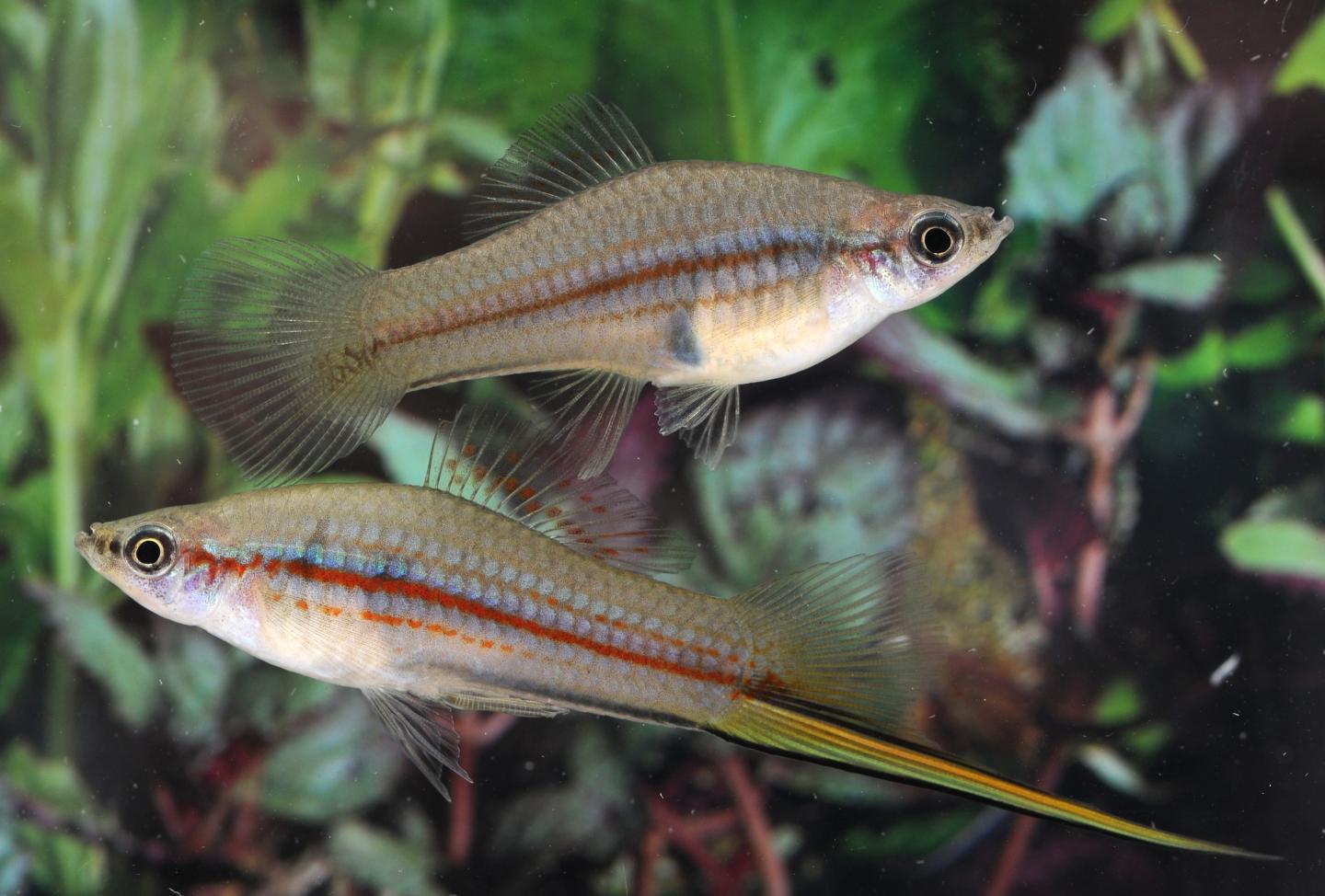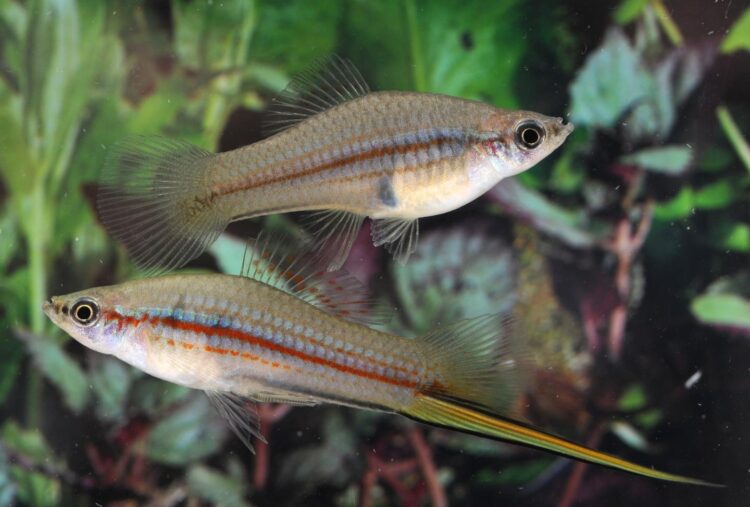
Credit: Georg Schneider / Uni Würzburg
The tail feathers of the peacock, the enormous horn of male rhinoceros beetles, the protruding antlers of some deer: In nature, there are countless examples of features which at first sight may only have disadvantages for their owners. After all, it is more difficult to hide from a predator when one is wearing a colourful plumage, and large antlers do not make escaping in the forest any easier. As a rule, it is the male that has such characteristics.
The evolution of male ornaments has therefore been fascinating to biologists since ever. Already Charles Darwin wondered of how such exaggerated, energy-consuming and in principle harmful structures could have been created by natural selection. Using the example of the swordtail fish (Xiphophorus hellerii), he explained his theory of sexual selection. Darwin’s basic idea: If females prefer to mate with the carriers of striking ornamental traits, such traits might become established in the course of evolution even though they are likely to be harmful for their owners.
Publication in Current Biology
Scientists from Würzburg, Constance and the USA have now been successful in finding the genetic bases of this evolutionary model in Xiphophorus, also well known to aquarists as one of their favourite pets. Among all eligible genes, the researchers identified some that are responsible for the development of the corresponding ornamental trait in this species of fish. Their findings also suggest that in the swordtail a gene that is actually important for neuronal processes in the brain has taken on an additional new function during evolution.
The scientists published their findings in the journal Current Biology. Manfred Schartl, a senior professor at the Department of Developmental Biochemistry at the University of Würzburg, is the lead author of the study. The project was co-initiated by the evolutionary biologist Axel Meyer from Constance University with whom the Würzburg researchers have been investigating this phenomenon for many years. For more than two decades, the two laboratories at the Universities of Würzburg and Constance have jointly researched the genetic basis of the sword. The current study has now brought the scientists a big step closer to understanding the genetic basis of the extended caudal fin of swordtails.
“In several species of the genus Xiphophorus, the males carry a so-called ‘sword’, a striking extension of the lower edge of the tail fin, which is yellow, orange or red in colour and surrounded by a dark black margin,” explains Manfred Schartl. The sword develops during puberty and can be as long as the fish itself in some species. This should actually be a disadvantage, because the conspicuous body ornament attracts predators on the one hand and on the other hand makes escaping more difficult as it reduces swimming performance. However, the females of Xiphophorus hellerii and several related species prefer to mate with males that carry a long sword – males with shorter swords literally lose out in this competition.
Gradually excluding the suspects
The genetic bases of this extension of the caudal fin in Xiphophorus have previously been unknown. However, knowledge of this phenomenon is necessary to test hypotheses about the role of sexual selection at the molecular genetic level.
The scientists took a gradual approach to pinpointing the responsible genes. They started by looking for all genes that are specifically active in the sword developing part of the tail fin, but not in fin regions that do not form a sword. “This process resulted in a set of 329 differentially expressed genes in all sword transcriptomes,” said Schartl, describing the result. The term transcriptome refers to the entirety of genes that are transcribed in a cell or tissue at a certain point in time, i.e. are active.
The consideration that genes responsible for sword formation are only expressed in males led to a significant reduction in the number of suspects in the next step. The scientists created transcriptomes of cells from specific areas of the caudal fins in both male and female specimens. If the females showed comparable activities to males, it was clear that these genes are not among the sought-after candidates. After this process, 255 of the original 329 genes remained.
“Interestingly, this comparison revealed that a spatial pattern of five transcription factors – Zic1, Hoxb13a, Six2a, Tbx3a and Pax9 – is responsible for organising the preconditions in the caudal fin for the development of a sword, and that this pattern is also present in females,” said Schartl.
Backcrossings provide important information
Genetic mapping came next to further reduce the still high number of 255 candidate genes. For this purpose, swordtail males were crossed with females of a related species whose males had lost their sword in the course of evolution. The male descendants from this mating have swords of different lengths due to the mixing of the parental genomes depending on their random genetic make-up. Sequencing those genomes using special high-throughput techniques then made it possible to correlate certain chromosome segments with sword formation, and those with the list of candidate genes. Finally, three genes were left over.
Spotlight on one main suspect
The gene with the scientific name kcnh8 proved to be crucial for the development of the male characteristic. “This gene codes for a potassium channel – a group of channels that play an important role in particular in the transmission and processing of stimuli in the nervous system,” said Schartl. The new findings point to a gene with a primary function in neural cells that was recruited during evolution for developing the male sword about three to five million years ago, i.e. early during the diversification of swordtail fishes. The new function is not due to structural changes within the gene and its product, but to changes in gene regulation.
Indeed, experiments show that kcnh8 in the sword during normal development and after treatment with male hormones is highly upregulated in the region where the sword is organised. In all other fin areas of the males and in female caudal fins it is only weakly expressed. In addition, further studies show a direct correlation between the level of gene expression of kcnh8 and the length of swords.
Support of botanists of the JMU
Schartl and Meyer received support for their research on potassium channels from an expected source: botanists from the University of Würzburg. Rainer Hedrich, who heads the Department of Molecular Plant Physiology and Biophysics, and his colleague, Professor Dietmar Geiger, have been studying potassium channels for a long time. The techniques they used – special patch-clamping methods – could be easily transferred from plants to the fish.
Potassium channels transport electrically charged particles and thus cause changes in the membrane potential in cells and tissues. According to the scientists, such channels create tissue-wide bioelectric gradients which affect the overall structure of the cellular microenvironment. Similar phenomena have been observed in the proliferation of cancer cells and have led to hypotheses about the importance of ion gradients for growth control. The role of Kcnh8 in the development of the ventral caudal outgrowth in male swordtails is in good agreement with these models.
###
Media Contact
Prof. Dr. Manfred Schartl
[email protected]
Original Source
https:/
Related Journal Article
http://dx.





